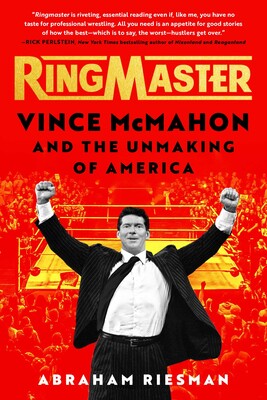Ringmaster: Vince McMahon and the Unmaking of America
- By Abraham Josephine Riesman
- Atria Books
- 464 pp.
- Reviewed by Michael Maiello
- April 3, 2023
Did the wrestling mastermind really destroy politics in the U.S.?

In the United States, we love celebrities, so it’s no surprise we’ve elected a cowboy actor and a reality-TV-show star president. The former had at least been governor of California before reaching the White House. The latter, however, had most notably faced off against a close friend and fellow billionaire in a high-profile professional wrestling match where the loser had his head shaved by the victor.
The moguls battling hair-for-hair were Vince McMahon and Donald Trump. McMahon is the subject of Abraham Josephine Riesman’s comprehensive and skillful Ringmaster, which argues provocatively that McMahon and Trump rose together — often helping each other — to win fortune and power in a changing media and political landscape that the author dubs “the unmaking of America.”
As McMahon built his fortune, he befriended Trump and spent some of that fortune to help Trump become president. McMahon and his wife, Linda, are among the richest and most devoted Trumpists; Linda even served in Trump’s cabinet, leading the Small Business Administration. More importantly, McMahon participated in and benefited from the creation of a consolidated national media and entertainment economy that has profoundly impacted how Americans relate to the world. Along the way, he turned himself into an onscreen character based on himself — a slick, flashy narcissist — who inspired both Trump and Trump’s supporters.
“Kayfabe” is a term people inside the pro-wrestling world once used to describe the measures taken to make the sport seem real. Once upon a time, heroes and villains of the ring would not be seen together at bars and restaurants or sharing rental cars. They wouldn’t break character in public if they might be recognized. Fans who thought the spectacle was real were “marks.” Those who were wise to the ruse had “smartened up.” But some thought the industry would die if too much of the public knew the truth. As late as 1984, the prime-time news program “20/20” deemed exposing the con a major story.
Riesman understands the appeal of pro wrestling, which has long been transgressive and deeply conservative at the same time. Here, the author describes the hulking Jesse “The Body” Ventura, who would one day become governor of Minnesota:
“Constantly admiring his own male form and clad in colorful scarves and tops that would look right at home in a contemporary gay bar, but ostensibly straight, Ventura was a perfect example of wrestling’s long-standing and uneasy détente between machismo and camp.”
Pro wrestling’s dual embrace of Charles Atlas physiques and theatrical flamboyance creates a space for ambiguity to thrive. Each member of the audience sees things as they want. “Alternative facts,” a phrase from early in the President Trump era, emerge from these collisions between reality and perception. Kayfabe held things together by centering the show around winners and losers or champions and challengers.
Starting the story in midcentury America, Riesman energetically chronicles McMahon’s journey from impoverished, abused youth in South Carolina to finding his biological father, the owner of Washington, DC’s Capitol Wrestling Corporation. McMahon apprenticed at the business and later bought it, focusing on wrestling and other entertainments in the Northeast. He encountered a balkanized pro-wrestling world, with regional promoters organized into virtual fiefdoms. McMahon quickly recognized the emerging cable television as a path to national prominence.
Even in the age of kayfabe, he routinely told people that wrestling was scripted, often to free his business from the oversight of state athletic commissions. He viewed wrestling as an entertainment like any other and surmised that its veneer of realism mattered little. By the mid-1980s, McMahon had partnered with MTV to sell wrestling to yuppies coast to coast, drawing celebrities like Cyndi Lauper, Mr. T., and Andy Warhol into the first WrestleMania, now a 39-year annual tradition.
Of course, the saga of the larger-than-life McMahon also includes his alleged knowledge of a murder, numerous accusations of sexual assault, a federal prosecution for steroid distribution, an ill-fated bodybuilding competition, and an industry-altering incident known as “the Montreal Screw Job.” Riesman renders each in fast-moving, eye-opening detail.
The story winds up in our fact-challenged present. It turns out that contemporary audiences — like contemporary voters — don’t fret much over what’s real. For wrestling fans, objecting that the massive Brock Lesnar didn’t actually try to murder champion Roman Reigns with a tractor during SummerSlam would be like “Black Panther” viewers complaining they’d been lied to about Wakanda’s existence.
Vince McMahon, who always saw himself as more of a Walt Disney than a Don King, now sits atop his own magic kingdom, a public company he’s trying to sell for a reported $9 billion. Meanwhile, his old pal Donald Trump is trying to become president again. Does this story ever end?
Michael Maiello is an author, journalist, and playwright. He worked for 10 years as a writer and editor at Forbes, and his work has appeared in McSweeney’s, the New Yorker, the New York Times, and other publications. Find his free Substack here.

